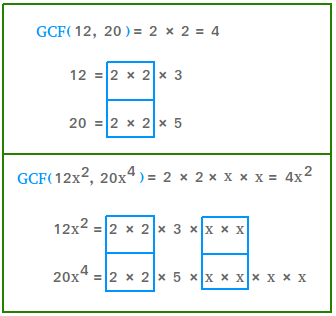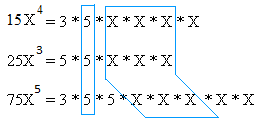Finding the Greatest Common Factor of an Expression
In greatest common factor, finding the greatest common factor of numbers was the goal. In this lesson, we will do the same thing, but we will take the concept to the next level by looking for the greatest common factor of expressions.
Recall that if we are looking for the GCF of 12 and 20, we need to first factor each number into its prime factorization as shown in the figure below.
As you can see, 2 × 2 = 4 is the greatest factor 12 and 20 have in common, so 4 is the GCF of 12 and 20.

Find the GCF of 12x2 and 20x4
Now, not only we need to expand 12 and 20 into their prime factorizations, we also need to do the same for x2 and x4 as demonstrated in the figure above.
As you can see from the figure above, the GCF of 12x2 and 20x4 is 2 × 2 × x × x = 4x2
A few more examples showing how finding the greatest common factor of expressions work
Example #1
Find the GCF of 15x4, 25x3, and 75x5
First take a look at the figure below and study it carefully.

Thus, the GCF for 15x4, 25x3, and 75x5 is 5 × x × x × x = 5x3
There is a faster way to find the greatest common factor of an expression.
When there are many exponential expressions that have the same variable or same number as base, the greatest common factor is the expression with the smallest exponent.
For example, the greatest common factor of x4, x3, and x5 is x3 since x3 is the expression with the smallest exponent. By the same token, the greatest common factor of 32, 34, and 33 is 32 since 32 is the expression with the smallest exponent.
Example #2
Find the GCF of w3 + w2 + w
We can break down this trinomial into three separate expressions: w3, w2, and w.
Since w is the expression with the smallest exponent, w is the greatest common factor.
Example #3
Find the GCF of 4w5 + 8w4 + 16w3
4w5 + 8w4 + 16w3 = 22w5 + 23w4 + 24w3
We can break down this trinomial into three separate expressions: 22w5,23w4,and 24w3
For 22, 23, and 24, the GCF is 22
For w5, w4, and w3, the GCF is w3
Therefore, the GCF of 4w5 + 8w4 + 16w3 is 22w3 or 4w3